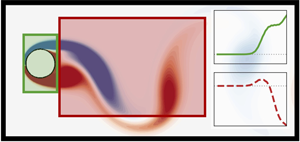Crossref Citations
This article has been cited by the following publications. This list is generated based on data provided by
Crossref.
Menon, Karthik
and
Mittal, Rajat
2021.
Significance of the strain-dominated region around a vortex on induced aerodynamic loads.
Journal of Fluid Mechanics,
Vol. 918,
Issue. ,
Wang, Tso-Kang
and
Shoele, Kourosh
2021.
Geometrically weighted modal decomposition techniques.
Journal of Fluid Mechanics,
Vol. 911,
Issue. ,
Menon, Karthik
and
Mittal, Rajat
2021.
Quantitative analysis of the kinematics and induced aerodynamic loading of individual vortices in vortex-dominated flows: A computation and data-driven approach.
Journal of Computational Physics,
Vol. 443,
Issue. ,
p.
110515.
Wang, Tso-Kang
Tripathi, Akriti
Shahriar, Al
Tavanashad, Vahid
Kumar, Rajan
and
Shoele, Kourosh
2021.
Flow-Informed Vibration-Based Health Monitoring Technique.
Chen, Weilin
Zhao, Yawei
Ji, Chunning
Srinil, Narakorn
and
Song, Liqun
2021.
Experimental observation of flow-induced vibrations of a transversely oscillating D-section prism.
Physics of Fluids,
Vol. 33,
Issue. 9,
Noda, Hiroshi
Mittal, Rajat
Seo, Jung-Hee
and
Menon, Karthik
2022.
Investigation of aerodynamic instability vibration of rectangular cylinder based on energy transfer.
Journal of Wind Engineering and Industrial Aerodynamics,
Vol. 220,
Issue. ,
p.
104825.
Badhurshah, Rameez
Bhardwaj, Rajneesh
and
Bhattacharya, Amitabh
2022.
Energy extraction via Vortex-Induced Vibrations: The effect of spring bistability.
Journal of Fluids and Structures,
Vol. 114,
Issue. ,
p.
103708.
Chen, Weilin
Ji, Chunning
Alam, Md. Mahbub
Xu, Dong
An, Hongwei
Tong, Feifei
and
Zhao, Yawei
2022.
Flow-induced vibrations of a D-section prism at a low Reynolds number.
Journal of Fluid Mechanics,
Vol. 941,
Issue. ,
Seo, Jung-Hee
Menon, Karthik
and
Mittal, Rajat
2022.
A method for partitioning the sources of aerodynamic loading noise in vortex dominated flows.
Physics of Fluids,
Vol. 34,
Issue. 5,
Seo, Jung-Hee
and
Mittal, Rajat
2022.
Improved swimming performance in schooling fish via leading-edge vortex enhancement.
Bioinspiration & Biomimetics,
Vol. 17,
Issue. 6,
p.
066020.
Ong, Muk Chen
and
Yin, Guang
2022.
On the three-dimensional wake flow behind a normal flat plate.
Physics of Fluids,
Vol. 34,
Issue. 1,
Mittal, Rajat
and
Bhardwaj, Rajneesh
2022.
IMMERSED BOUNDARY METHODS FOR THERMOFLUIDS PROBLEMS
.
Annual Review of Heat Transfer,
Vol. 24,
Issue. 1,
p.
33.
Chen, Weilin
Ji, Chunning
Xu, Dong
and
Zhang, Zhimeng
2022.
Three-dimensional direct numerical simulations of vortex-induced vibrations of a circular cylinder in proximity to a stationary wall.
Physical Review Fluids,
Vol. 7,
Issue. 4,
Hasheminejad, Seyyed M.
and
Masoumi, Yasin
2022.
Smart hybrid VIV control of a linearly sprung cylinder using an internal semi-active NES-based vibration absorber coupled with two active rotating wake-control rods.
Ocean Engineering,
Vol. 266,
Issue. ,
p.
112310.
Ojo, Oluwafemi
Wang, Yu-Cheng
Erturk, Alper
and
Shoele, Kourosh
2022.
Aspect ratio-dependent hysteresis response of a heavy inverted flag.
Journal of Fluid Mechanics,
Vol. 942,
Issue. ,
Menon, Karthik
Kumar, Sushrut
and
Mittal, Rajat
2022.
Contribution of spanwise and cross-span vortices to the lift generation of low-aspect-ratio wings: Insights from force partitioning.
Physical Review Fluids,
Vol. 7,
Issue. 11,
Nitti, A.
De Cillis, G.
and
de Tullio, M.D.
2022.
Cross-flow oscillations of a circular cylinder with mechanically coupled rotation.
Journal of Fluid Mechanics,
Vol. 943,
Issue. ,
Hassanpour, Maziyar
Morton, Chris
and
Martinuzzi, Robert J.
2023.
Relationship between wake and cylinder dynamics for a cylinder undergoing modulated vortex-induced vibrations.
Physics of Fluids,
Vol. 35,
Issue. 12,
Cheng, Zhi
Lien, Fue-Sang
Dowell, Earl H.
Yee, Eugene
Wang, Ryne
and
Zhang, Ji Hao
2023.
Critical effect of fore-aft tapering on galloping triggering for a trapezoidal body.
Journal of Fluid Mechanics,
Vol. 967,
Issue. ,
Seo, Jung-Hee
Zhang, Yang
Mittal, Rajat
and
Cattafesta, Louis N.
2023.
Vortex-induced sound prediction of slat noise from time-resolved particle image velocimetry data.
Experiments in Fluids,
Vol. 64,
Issue. 5,



